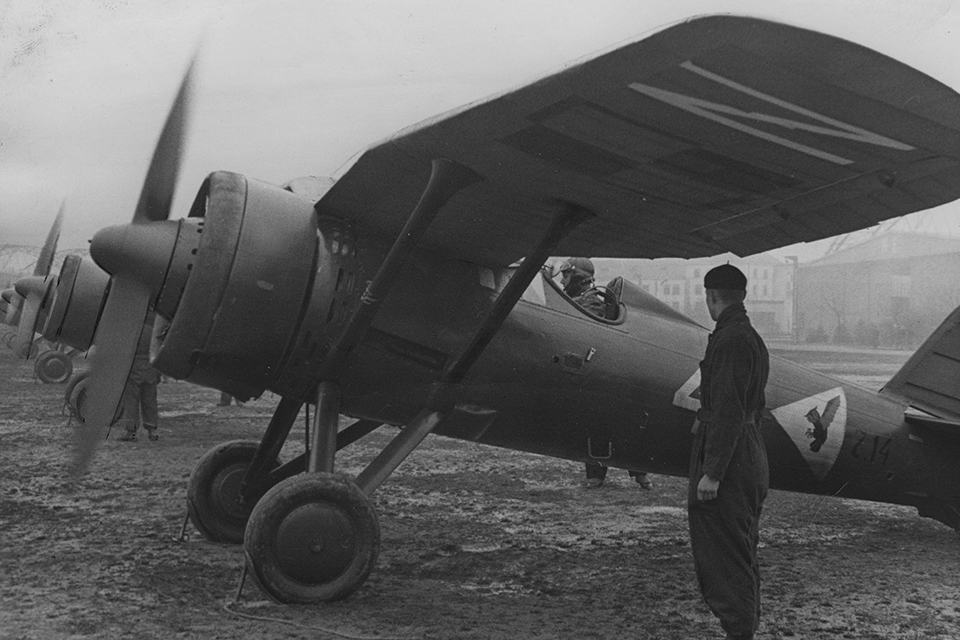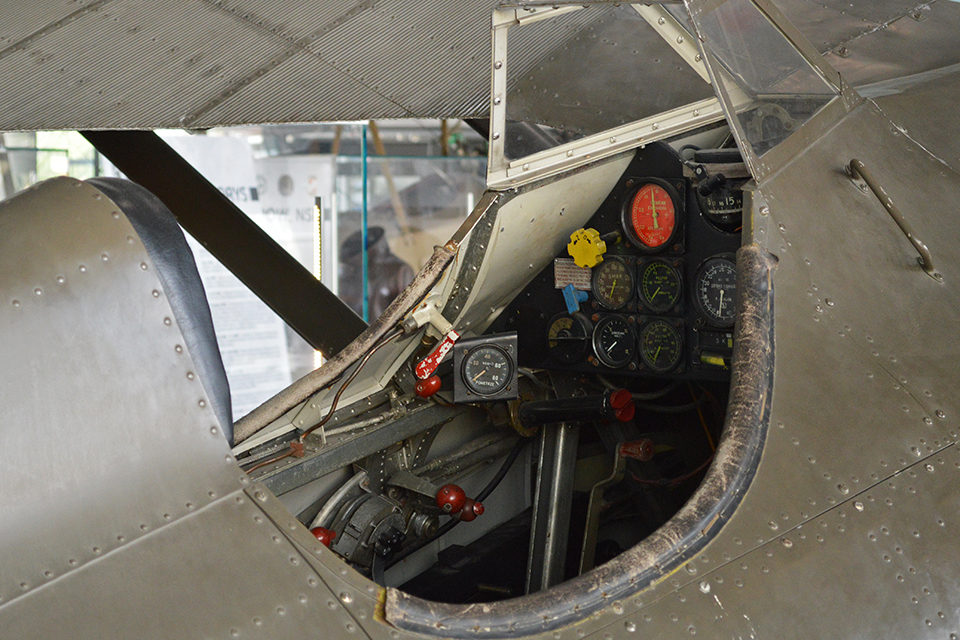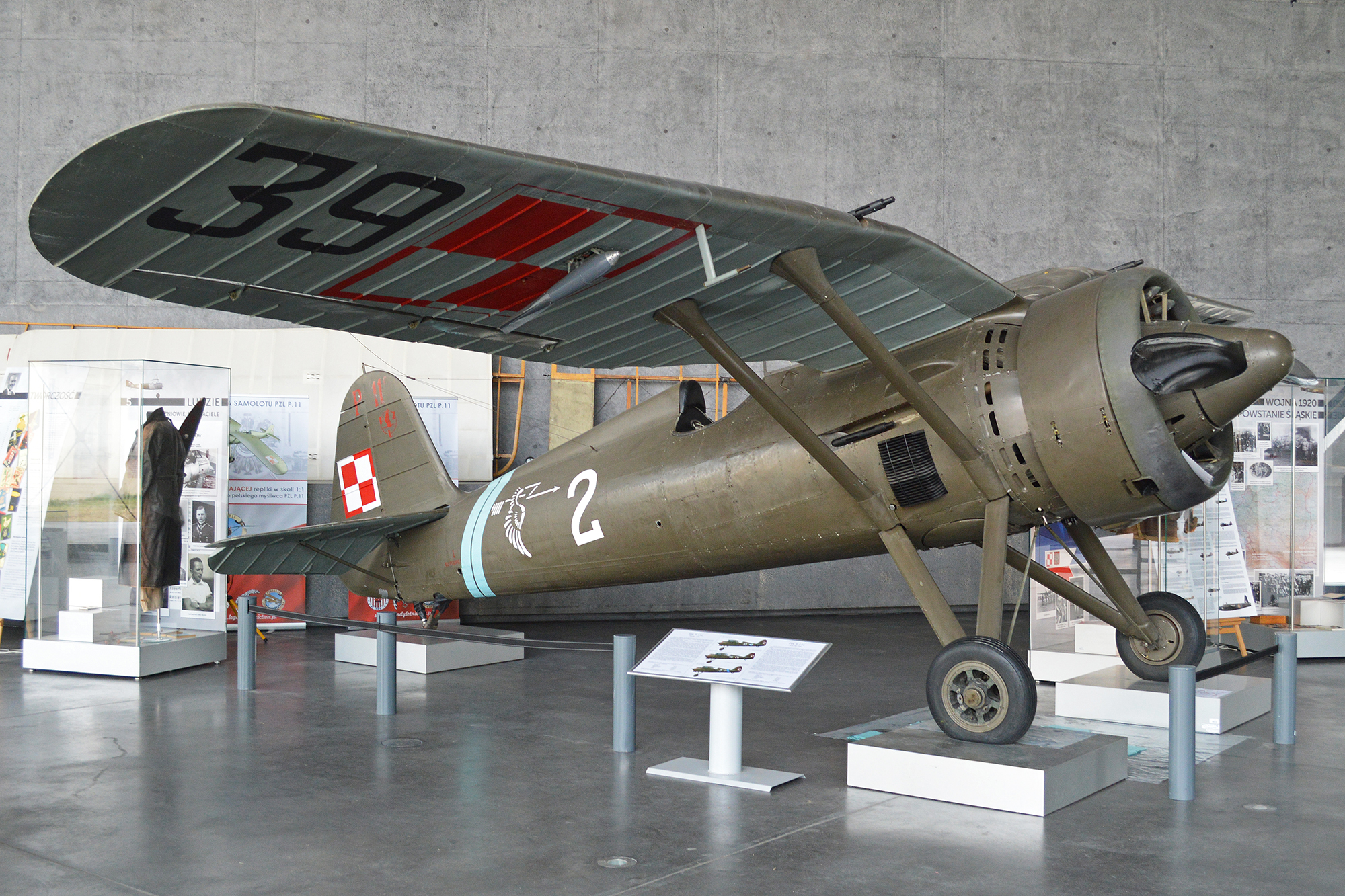When Germany invaded Poland on September 1, 1939, one of its key objectives was to annihilate the Polish air force. One reason the Luftwaffe failed to achieve that goal was the Polish Ministry of Defense’s decision to order all warplanes relocated to privately owned fields, leaving behind only damaged, defective or otherwise nonoperational planes to serve as decoys. In order to maintain secrecy, on August 28 the defense ministry issued orders through the Ministry of Agriculture to land owners living close to airfields. After those owners agreed on a purchase price for their land, the planes were moved onto far-flung fields and camouflaged. One such aircraft, a PZL P.11c of the 121st Fighter Squadron, was relocated to Morawica, near Balice, thus sparing it from destruction on the first day of the German onslaught. It was just the first in a series of lucky breaks that led the P.11c to a place of honor at Krakow’s Polish Aviation Museum.
Built by the Pánstwowe Zaklady Lotnicze (National Aviation Establishment) in August 1931, the PZL P.11c was among the last of a series of high-wing monoplanes created by Zygmunt Pulawski, who died in March 1931, but whose work was continued by Vsievolod Jakiemuk. Their designs were considered advanced when the first PZL P.1 flew on September 26, 1929, and in 1933 the improved P.6 and P.7 gave Poland the first air arm fully equipped with all-metal monoplane fighters. Foremost among their innovations were wings made of light but strong corrugated aluminum sheet, whose gull configuration gave the pilot a better view from the cockpit. Other advanced features included a scissors-type undercarriage suspension with the damper inside the fuselage, as well as the half-shell form of the fuselage, introduced in the P.7. In case of fire, the main fuel tank could be automatically jettisoned.
Powered by a 600-hp Skoda-built Bristol Mercury V S2 9-cylinder radial engine, the P.11 prototype was a hit at the Paris Aviation Fair in December 1934, and Romania purchased a license to produce 70 of its own, using 610-hp Gnome-Rhône 9K Mistral engines. Entering Polish service in early 1935, the P.11c had a maximum speed of 242 mph at 18,045 feet and was armed with four 7.7mm KM Wz.33 machine guns in the fuselage and wings. By 1939, 170 P.11cs had been built, but they had clearly become outdated—the Messerschmitt Bf-109D, for example, was 68 mph faster, and even German bombers such as the Dornier Do-17 and Heinkel He-111 could outrun the Polish fighter. Various upgrade projects, such as the P.11g, P.37 and P.50, all fell short of ideal— and in any case there was no time to put them into production before the German invasion.

On the morning of September 1, three Junkers Ju-87B-1s of I Gruppe, Sturzkampfgeschwader 2, were returning from their first dive-bombing mission when they passed over Moravica just as PZLs of the III/2 Division, comprising the 121st and 122nd squadrons, were taking off. By sheer chance one of the Stuka pilots, Sergeant Frank Neubert, managed to shoot down the lead P.11c, killing division commander Captain Mieszyslaw Medwecki, Poland’s first air casualty of the war. Medwecki’s wingman, 2nd Lt. Wladyslaw Gnys of the 121st Squadron, evaded the Stukas and got his revenge soon afterward when he shot down two Do-17Es of Kampfgeschwader 77.
Fighting on throughout the campaign, P.11cs destroyed about 120 German aircraft before Poland fell. One surviving P.11c that had been flown by the deputy commander of the 121st Squadron was delivered to Berlin as a war trophy, with bullet holes in the engine and wings. Luftwaffe Reichsmarschall Hermann Göring included the aircraft in his collection in the Deutsche Luftfahrtsammlung until November 1943, when British planes attacking a nearby railroad station also dropped bombs on the museum.
Göring subsequently had the whole display packed up, loaded on three trains and transported out of the capital. Most of the aircraft had their wings removed or were damaged in the course of fitting them inside the railroad cars. But the little P.11c remained intact throughout the process.
The fate of two of those trains remains a mystery, but the third arrived in western Poland, where Soviet forces later discovered it near Poznan. After being returned to Polish custody, the P.11c traveled to Pilawa, then Wroclaw, and finally to Krakow for an aviation exhibition in 1963.
By that time the fighter’s fuselage was corroding, the nose section had been damaged and its finish needed a serious makeover. But the newly opened museum lacked the facilities to perform anything more than minor repairs. Repainted in green and light blue, the plane remained on display in that state for nearly 25 years.
In the late 1980s, Warsaw-based PZL “Okacie,” the firm that had originally built the fighter, undertook a full restoration. The disassembled aircraft arrived by ground transport and was placed in a hangar, where specialists from various fields, helped by students from the aviation school associated with PZL, worked overtime to restore it. Aside from some assistance from the Central Army Library, which provided instruction manuals and other documentation, they had no outside help with the project.
The biggest task facing them was to reconstruct the fuselage, a large portion of which, along with the wings, had to be covered with new corrugated metal and reriveted. The metal sheets were produced by the team members, using a machine they had constructed. They also reconstructed the nose section, damaged during an emergency landing, including the exhaust collector.
Finally the entire aircraft had to be repainted. After removing all the unoriginal paint layers with acetone, the crew uncovered the plane’s original finish, including the insignias. Through trial and error, the restorers produced two appropriate color mixes of olive green for the upper surfaces and blue-gray for the undersides of the wings and horizontal stabilizers. After that they painted unit and personal markings on the fuselage. A new set of wheels was attached, and two models of 7.92mm PWU Wz.33 machine guns were installed in the cockpit. In addition, two dummy bombs were fastened to the wire release mechanisms under the wings. The entire project took almost two years.

From Warsaw the airframe was transported back to Krakow, where the museum repaired the engine and propeller assembly. The engine is in working order, although it has so far only been started a few times for the public. The plane is not flyable because the rivets in the fuselage have been judged insufficient to withstand the pressures of flight— and nobody wants to risk losing the world’s only original P.11c in an accident.
Krakow’s museum originated from the aviation exhibition hosted by the Polish Aeroclub at a former airport at Rakowice-Czyzny, where many WWII aircraft were placed on display. During 1964 the exhibition was transformed into an aviation equipment exhibition center, and in 1967 it became the Aviation Museum. Since then it has acquired 177 airplanes, seven helicopters and 22 gliders, as well as one of the largest collections of aero engines in Europe— more than 150. Each year some 70,000 visitors tour the facility.
Thanks to support from Poland’s Ministry of Defense as well as private sponsors, the museum is constantly expanding and improving its exhibits. Director Krzysztof Radwan hopes to add a Mikoyan-Gurevich MiG-29 as well as NATO aircraft such as the British Aerospace Harrier, Jaguar, Lockheed F-104 Starfighter and Northrop F-5. Recent additions have included a Saab J35 Draken and JA37 Viggen, a de Havilland D.H.82 Tiger Moth, the entire MiG-21 series and a Yakovlev Yak-40. For now, however, the jewel in the museum’s crown remains the little fighter that fired the first shots of Poland’s six-year-long air war, the PZL P.11c.
Originally published in the July 2008 issue of Aviation History. To subscribe, click here.





